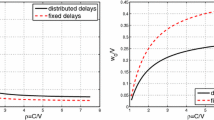Abstract
We analyze replicator dynamics with strategy-dependent time delays in a certain three-player game with one pure and two mixed Nash equilibria. In such a model, new players are born from parents who interacted in the past. We show that stationary states depend on time delays. Moreover, at certain time delays, interior equilibria cease to exist.



Similar content being viewed by others
References
Alboszta J, Miȩkisz J (2004) Stability of evolutionarily stable strategies in discrete replicator dynamics with time delay. J Theor Biol 231:175–179
Ben Khalifa N, El-Azouzi R, Hayel Y (2018) Discrete and continuous distributed delays in replicator dynamics. Dyn Games Appl 8:713–732
Ben Khalifa N, El-Azouzi R, Hayel Y, Mabrouki I (2016) Evolutionary games in interacting communities. Dyn Games Appl 7:131–156
Bodnar M (2000) On the nonnegativity of solutions of delay differential equations. Appl Math Lett 13:91–95
Broom M, Cannings C, Vickers GT (1997) Multi-player matrix games. Bull Math Biol 59:931–952
Broom M, Cannings C (2002) Modelling dominance hierarchy formation as a multi-player game. J Theor Biol 219:397–413
Broom M, Rychtář J (2012) A general framework for analysing multiplayer games in networks using territorial interactions as a case study. J Theor Biol 302:70–80
Bukowski M, Miȩkisz J (2004) Evolutionary and asymptotic stability in symmetric multi-player games. Int J Game Theory 33:41–54
Gokhale CS, Traulsen A (2010) Evolutionary games in the multiverse. Proc Natl Acad Sci USA 107:5500–5504
Gokhale CS, Traulsen A (2011) Strategy abundance in evolutionary many-player games with multiple strategies. J Theor Biol 83:180–191
Gokhale CS, Traulsen A (2012) Mutualism and evolutionary multiplayer games: revisiting the Red King. Proc R Soc B 279(1747):4611–4616
Haigh J, Canning C (1989) The n-person war of attrition. Acta Appl Math 14:59–74
Hofbauer J, Shuster P, Sigmund K (1979) A note on evolutionarily stable strategies and game dynamics. J Theor Biol 81:609–612
Hofbauer J, Sigmund K (1998) Evolutionary games and population dynamics. Cambridge University Press, Cambridge
Iijima R (2011) Heterogeneous information lags and evolutionary stability. Math Soc Sci 63:83–85
Iijima R (2012) On delayed discrete evolutionary dynamics. J Theor Biol 300:1–6
Kamiński D, Miȩkisz J, Zaborowski M (2005) Stochastic stability in three-player games. Bull Math Biol 67:1195–1205
Kim Y (1996) Equilibrium selection in n-person coordination games. Games Econ Behav 15:203–227
Křivan V, Cressman R (2017) Interaction times change evolutionary outcome: two-player matrix games. J Theor Biol 416:199–207
Kuang J (1993) Delay differential equations with applications in population dynamics. Academic Press, London
Maynard Smith J, Price GR (1973) The logic of animal conflict. Nature (London) 246:15–18
Maynard Smith J (1982) Evolution and the theory of games. Cambridge University Press, Cambridge
Miȩkisz J (2004) Stochastic stability in spatial three-player games. Physica A 343:175–184
Miȩkisz J, Wesołowski S (2011) Stochasticity and time delays in evolutionary games. Dyn Games Appl 1:440–448
Miȩkisz J, Matuszak M, Poleszczuk J (2014) Stochastic stability in three-player games with time delays. Dyn Games Appl 4:489–498
Miȩkisz J, Bodnar M (2019) Replicator dynamics with strategy-dependent time delays, preprint
Moreira JA, Pinheiro FL, Nunes N, Pacheco JM (2012) Evolutionary dynamics of collective action when individual fitness derives from group decisions taken in the past. J Theor Biol 298:8–15
Oaku H (2002) Evolution with delay. Jpn Econ Rev 53:114–133
Pacheco JM, Santos FC, Souza MO, Skyrms B (2009) Evolutionary dynamics of collective action in n-person stag hunt dilemmas. Proc R Soc B 276:315
Santos MD, Pinheiro FL, Santos FC, Pacheco JM (2012) Dynamics of N-person snowdrift games in structured populations. J Theor Biol 315:81–86
Souza MO, Pacheco JM, Santos FC (2009) Evolution of cooperation under N-person snowdrift games. J Theor Biol 260:581–588
Tao Y, Wang Z (1997) Effect of time delay and evolutionarily stable strategy. J Theor Biol 187:111–116
Taylor PD, Jonker LB (1978) Evolutionarily stable strategy and game dynamics. Math Biosci 40:145–156
Weibull J (1995) Evolutionary game theory. MIT Press, Cambridge
Wesson E, Rand R (2016) Hopf bifurcations in delayed rock-paper-scissors replicator dynamics. Dyn Games Appl l6:139–156
Wesson E, Rand R, Rand D (2016) Hopf bifurcations in two-strategy delayed replicator dynamics. J Bifurc Chaos 26(1650006):1–13
Acknowledgements
We would like to thank the National Science Centre, Poland for a financial support under the Grant No. 2015/17/B/ST1/00693.
Author information
Authors and Affiliations
Corresponding author
Additional information
Publisher's Note
Springer Nature remains neutral with regard to jurisdictional claims in published maps and institutional affiliations.
Appendix
Appendix
Proof of Theorem 1
Let us denote \(\alpha =\frac{\tau _A}{\tau _A-\tau _B}\). The equation \(F(x)=0\) is equivalent to \(F_L(x)= F_R(x)\), where
First, we consider the case \(\tau _B>\tau _A\). We calculate the second derivative of \(F_L\) with respect to x and we get
After some computations (reducing the expression in brackets to a common denominator and plotting—or estimating—a polynomial of the fifth degree of the numerator) it is possible to show that \(F_L''(x)<0\) for all \(x\in (0,1)\) and \(\alpha <0\). Thus, \(F_L\) is concave. On the other hand, the derivatives of \(F_R\) read
where
Plotting the polynomial of the fifth degree shows that the coefficient in \(\alpha \) is positive for \(x\in (0,1)\), and therefore, \(h(x)<0\) for \(x\in (0,1)\). Thus, \(F_R\) is convex. This proves that equation \(F_L(x)=F_R(x)\) has at most two solutions in (0, 1).
Note that in this case (\(\tau _A<\tau _B\)), we have
and
If we compare the value of \(F_L\) and \(F_R\) at \(x=\frac{1}{2}\), we deduce that if
then \(F_L(\frac{1}{2}) > F_R(\frac{1}{2})\) so there are exactly two solutions of \(F_L(x)=F_R(x)\) in the interval (0, 1).
On the other hand, one can easily estimate that
for all \(x\in (0,1)\). Because \((1-x)^2+4x(1-x)\le 4/3\) and \(x^2 + 2(1- x)^2\ge \frac{2}{3}\), one deduce that \(F_R(x) \ge \frac{1}{2}\). This completes the proof of part (ii) of the theorem.
Now, assume that \(\tau _A>\tau _{B}\) which implies that \(\alpha >1\). In this case, it is convenient to change variables. Let
The problem of finding solution of \(F_L(x)=F_R(x)\) for \(x\in (0,1)\) transforms to the problem of finding solution of \(G_L(y)=G_R(y)\) for \(y>0\), where
It is very easy to calculate limits of \(G_L\) and \(G_R\) at 0 and at \(+\infty \) and get
We calculate the derivative of \(G_L\) and we get
It is easy to see that for \(\alpha >1\), the function \(G_L\) is decreasing for \(y\in (0,{\tilde{y}})\) with \(\displaystyle {\tilde{y}} = \frac{1+\sqrt{33}}{8}\), and it is increasing for \(y>{\tilde{y}}\). Note also that
while \(G_R(Y)>0\) for \(y>0\). Now, we prove that \(G_R\) is increasing on \((0,{\tilde{y}})\). We calculate the derivative of \(G_R\) with respect to y and we obtain
with
Because \({\tilde{y}}<2\) and \(\alpha >1\), we easily see that \(g(y)>0\) for \(y\in (0,{\tilde{y}})\). Thus, \(G_R\) is increasing in \((0,{\tilde{y}})\), and therefore, there exists exactly one solution of \(G_L(y)=G_R(y)\) in \((0,{\tilde{y}})\).
One can see that \(G_L(x) =0\) for \({\hat{y}}_1=2-\sqrt{3}\) and \({\hat{y}}_2=2+\sqrt{3}\). As \({\hat{y}}_2>2>{\tilde{y}}\), we see that \(g(y)<0\) for \(y>{\hat{y}}_2\), thus \(G_R\) is decreasing while \(G_L\) is increasing for \(y>{\hat{y}}_2\). Thus, the second solution to \(G_L(y)=G_R(y)\) exists in the interval \(({\tilde{y}}, +\infty )\) if and only if \(G_L(+\infty )>G_R(+\infty )\), that is \(\alpha \ln 2 > 2^{1-\alpha }\). Some simple algebra finishes the proof of the theorem. \(\square \)
1.1 Formula Used for Drawing Stationary Solutions
Here, we derive a formula that gives us a better relation between \(\tau _A\), \(\tau _B\), and \({\bar{x}}\) than the equation \(F(x)=0\). As before, let us denote
The equation \(F(x)=0\) is then equivalent to
Thus,
where \(W_L\) is a Lambert W function, that is \(x = W_L(x)\exp \bigl (W_L(x)\bigr )\). Now, using the definition of \(\alpha \) we get
In this manner, we get a relation between \(\tau _A\) and \(\tau _B\) at the stationary state x, namely
In an analogous manner—denoting \(\beta = \frac{\tau _B}{\tau _A+\tau _B}\)—we get another relation between \(\tau _A\) and \(\tau _B\) at the stationary state x, namely
Rights and permissions
About this article
Cite this article
Bodnar, M., Miȩkisz, J. & Vardanyan, R. Three-Player Games with Strategy-Dependent Time Delays. Dyn Games Appl 10, 664–675 (2020). https://doi.org/10.1007/s13235-019-00340-0
Published:
Issue Date:
DOI: https://doi.org/10.1007/s13235-019-00340-0




